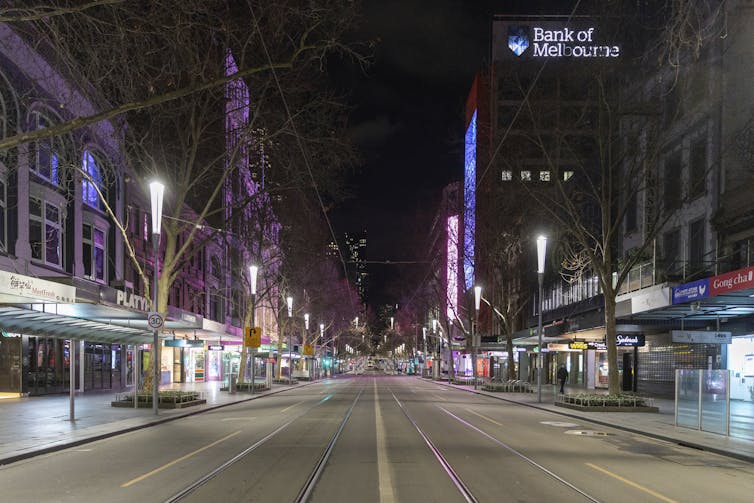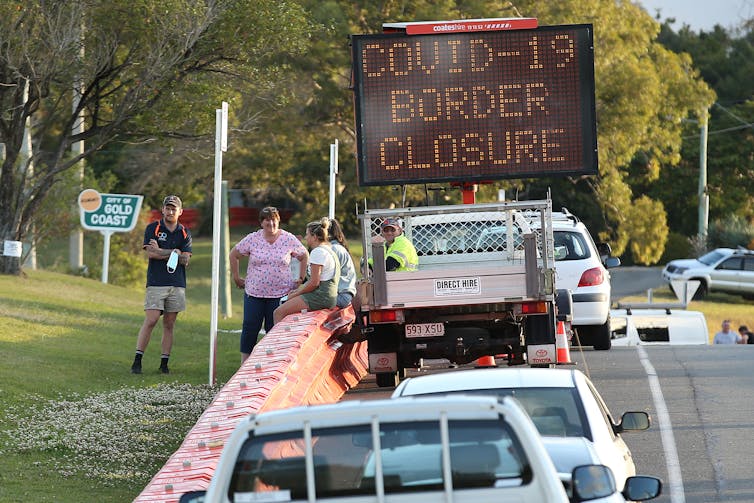With a post-lockdown Victoria in sight, the more we can contain transmission now, the easier the road ahead
- Written by Catherine Bennett, Chair in Epidemiology, Deakin University
Victoria’s roadmap[1] out of lockdown, released today, marks an important milestone. It’s a clear commitment to delivering on the National Plan[2], and provides much-needed clarity on where we are heading and what the next few months will look like. It is staged and sensible, striking the balance between opening up and maintaining a level of control over transmission.
The roadmap charts a course of staged reopening as more Victorians become vaccinated. It’s informed by modelling from the Burnet Institute[3], which makes some sobering predictions on the number of cases and the strain on our health system, no matter what course we take from here.
It steps us through what things will look like as we move from 80% of those aged 16 and older having had at least one dose, to 70% fully vaccinated, through to and 80% and beyond.
The potential risk of easing restrictions will be managed through a continued focus on outdoor activity and leveraging the lower risk of infection and, even more so, hospitalisation, in the growing number who are fully vaccinated.
Having a clear vision for where you are heading can make all the difference, especially when the time horizons are now within weeks. We need this, as it will still be a difficult transition through “the gateway” to living with COVID.
Balancing the risks
The roadmap was only one of five scenarios the Burnet team modelled and is in fact the least cautious. But the decision was taken to balance these risks with the direct and indirect health costs of delaying the easing of restrictions further.
The modelling forecasts twice the peak in case numbers, ICU admissions and deaths under the proposed path compared with staying under lockdown, or the other more restricted scenarios.
But it also shows that maintaining high levels of testing can mitigate some of this additional risk.
We have a road out, and one we can make less costly by testing when symptomatic, and abiding by the public health orders now the end is in reach.
So what does the plan say?
When 80% of Victorians have had a single vaccination dose
At 80% single dose coverage among those aged 16 and over, expected by September 26, the travel limit in Melbourne will extend to 15km.
Outdoor activities such as basketball, golf, tennis will be allowed, subject to the same people limits as picnics: two adults if unvaccinated, or up to five fully vaccinated.
In regional Victoria, final year VCAL (Victorian Certificate of Applied Learning) students will be allowed back to study onsite. Masks will no longer be required for beauty or personal care services.
When 70% of over-16s are double dosed
October heralds the staged return to partial onsite schooling, with further changes once 70% of those 16 and older are fully vaccinated, expected by October 26.
This marks the official ending of what we know as lockdown.
The curfew will also end in metro Melbourne and outdoor hospitality will open to those fully vaccinated.
 The lockdown and curfew will end when 70% of over-16s have had two doses of vaccine.
Asanka Brendon Ratnayake[4]
The lockdown and curfew will end when 70% of over-16s have had two doses of vaccine.
Asanka Brendon Ratnayake[4]
Weddings and funerals will be allowed outdoors for up to 50.
Students from all years will be able to return to face-to-face learning for at least part of the week in both Melbourne and regional Victoria.
Regional Victoria will also see further easing with up to 30 fully vaccinated patrons allowed indoors in hospitality venues.
When 80% of over 16s are double-dose vaxxed
When we get to 80% double dose coverage, projected for November 5, all of Victoria will share the same more modest restrictions.
Indoor activity will open further for those fully vaccinated, including retail, and caps will lift to 150 for organised indoor events and 500 outdoors.
Private gatherings of up to 30 people outdoors will be allowed, but only ten guests are allowed in the home, the setting deemed the highest risk.
Masks will only be required outdoors.
Read more: We've become used to wearing masks during COVID. But does that mean the habit will stick?[5]
By the end of the year
By year’s end, as we exceed 80% of adults fully vaccinated and aim for 80% including 12- to 15-year-olds, more visitors to the home will be allowed, possibly extending to 30 by Christmas.
International travel might be possible by then too, at least to low-risk countries.
 Interstate travel might be on the cards by Christmas – to some states.
Jono Searle/AAP[6]
Interstate travel might be on the cards by Christmas – to some states.
Jono Searle/AAP[6]
Interstate travel will also be on the cards, although this might be limited to New South Wales and ACT until other states also move to living with the virus.
Why lift restrictions on outdoor activities and for the vaccinated?
It makes sense to use outdoor settings and individual and population vaccination protection to progress on this road out to manage transmission risk.
Remaining unvaccinated is a greater risk now, even with these rules in place – 204 people in hospital this week, and only 1% of these fully vaccinated[7].
Vaccine passports won’t be a permanent fixture, but allow us to do more things earlier than otherwise possible.
Read more: Vaccine passports are coming to Australia. How will they work and what will you need them for?[8]
But it could be worse – or better
It’s important to recognise that the steps along the way may end up looking somewhat different depending on case numbers, perhaps for the better.
Lower case numbers as we start this transition will put us in a better position, as the Doherty modellers reported last week. So the more we contain transmission while in lockdown, the easier the road ahead and lowest impact on hospitals.
The immediate challenge has not changed. We still need to do everything we can to keep case numbers from rising and, if possible, bring them down. We still need to get vaccinated as quickly as possible and push coverage in those over 16 up to 80%, and beyond.
What has changed is that we can see clearly where we are heading and how our hard work to prevent further waves while waiting for the vaccine roll-out now translates into greater freedoms in coming months.
This is a critical transition period that will test us all, and it helps to see vaccination levels that can provide some relief within reach after a gruelling 18 months. With the end of this “pre-vaccine” phase within sight, a final push to control transmission over this last stretch makes this a safer and quicker passage through the gateway to living with the virus.
If we do better than the Burnet modelling assumes by getting tested when symptomatic, vaccinated or not, and abiding by the rules in place, we will come in well under the forecast case and death counts.
Victoria and NSW are watching and learning from each other as each state eases out of lockdown while keeping a level of control over the virus. Success will reassure other states and territories of how this can work, and allow Australia to once again be open for business.
Read more: NSW risks a second larger COVID peak by Christmas if it eases restrictions too quickly[9]
References
- ^ roadmap (www.premier.vic.gov.au)
- ^ National Plan (www.pmc.gov.au)
- ^ Burnet Institute (burnet.edu.au)
- ^ Asanka Brendon Ratnayake (photos.aap.com.au)
- ^ We've become used to wearing masks during COVID. But does that mean the habit will stick? (theconversation.com)
- ^ Jono Searle/AAP (photos.aap.com.au)
- ^ 1% of these fully vaccinated (www.dhhs.vic.gov.au)
- ^ Vaccine passports are coming to Australia. How will they work and what will you need them for? (theconversation.com)
- ^ NSW risks a second larger COVID peak by Christmas if it eases restrictions too quickly (theconversation.com)

















